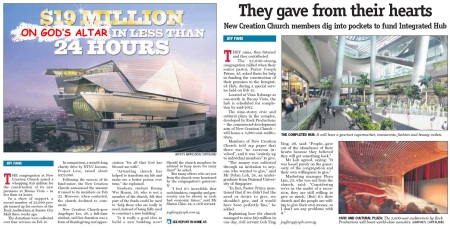one-north aims to be a place where residents can work, live, learn and play seamlessly. CLARISSA Tan reports
IT’S Friday morning. Your alarm rings. You decide to swim a few laps, so you head for the rooftop pool. Then you stroll to work, which takes only a few minutes. Throughout the day, you rub shoulders with academics, media types, a few artists.
Later you want to welcome the weekend with a bang. A host of restaurants and bars are just a short walk or an MRT stop away. And while your workplace is an impressive, futuristic building, you can opt to dine in a cosy colonial setting.
Living in one-north will help you enjoy this kind of lifestyle, according to some property developers and consultants. The 200-hectare area around Buona Vista, which includes scientific research centre Biopolis and media hub Fusionoplis, aims to be a place where residents can ‘work, live, learn and play’ seamlessly.
one-north’s ’self-contained township’ concept and proximity to a research-and-development hub, the Science Park and education campuses are a draw for researchers, academics and professionals, says Ku Swee Yong, director of marketing and business development at property consultant Savills Singapore.
‘Singapore has just begun to reap the benefits of R&D in the pure sciences,’ he says. ‘one-north is expected to contribute the lion’s share in the commercialisation value of these efforts’.
Two residential projects are under construction at one-north – one-north Residences and The Rochester.
The Rochester, going by the job-home-leisure concept, is a mixed development that will comprise a condominium, a business hotel and a mall.
The cluster will have ‘unparalleled accessibility,’ says Jackson Yap, group managing director and chief executive of developer United Engineers.
‘There’s the East-West MRT line a five-minute walk away at Buona Vista station and the Circle Line to be running by 2011. It is also a short drive to Orchard Road and walking distance to Holland Village.’
The Rochester Condominium will have 366 units. Besides being near the sleek towers of Biopolis and Fusionopolis, it will be flanked by the lush Rochester Park, a green belt with colonial black-and-white bungalows that have been leased to food-and-beverage outlets.
‘It enjoys all the amenities of a mature residential estate with the greenery of the Rochester Hill in the background,’ says Mr Yap.
The Rochester Mall will be 100,000 sq ft and the business hotel, called Park Avenue Suites @ The Rochester, will have 350 rooms.
‘Apart from serving business travellers to one-north, the hotel will cater to medical tourists, with the National University Hospital and Gleneagles in the vicinity,’ Mr Yap says.
It will also attract ‘edu-tourists’ on short-term post-graduate courses at the nearby INSEAD business school and the National University of Singapore, he adds.
The entire project should be completed by 2011.
one north Residences , developed by Vista Development, will have about 400 residential units and 20 street retail units. Its design concept leans towards glass and steel, with blocks connected by sky bridges, and fits in with the area’s master plan to create a ‘fenceless’ community.
‘Because there is a limited supply of residential projects there, demand for housing will be extremely great from expatriates who work there,’ says Emily Eng, associate director of the residential department of Knight Frank, the project’s marketing consultant and agent.
‘People who buy see the potential of the hub. After all, the government has committed to spend $15 billion to develop this city within the city.’
Savills’ Mr Ku says a development like one-north Residences will ‘allow like-minded experts and professionals to get together, mingle and socialise within a short walk of their home.’
Such is the concern for seamless interconnectivity that if you’re the sort who prefers to roll out of bed and into the office, you can opt to live in the very building where you work.
Fusionopolis, a twin-tower, 24-floor skyscraper dedicated to ‘infocomms’ or media and IT-related businesses, will house 50 serviced apartments. These units will have access to a rooftop pool, a clubhouse and skygardens – as well as five floors of entertainment and retail outlets including a supermarket, restaurants, a bookstore and a food court.
While one-north may look scientific, high-tech and top-speed at first glance, it also has a more laidback and historical side. Nestled in a green enclave is the Wessex Estate, a close-knit cluster of black-and-white houses and apartments built by the British in the 1940s.
While the various blocks of the Biopolis complex are given names such as Neuros, Genome and Chromos, the apartment buildings of Wessex Estate bear names that recall another time – Waterloo, Somme, Lucknow, Pegu.
And unlike the colonial district at Rochester Park, which now features restaurants and bars, the Wessex Estate is still very much residential and has a strong neighbourhood feel. The aim is to foster it as a home for artists, teachers, writers and actors. A few of the apartment blocks have been converted into work lofts for people involved in the creative and fine arts.
The Wessex Estate has always had interconnectivity of its own. For decades, its inhabitants could head down to the nearby Colbar (short for Colonial Bar), where pickled onions and fish-and-chips are on the menu.
The Colbar still exists and is as popular as ever, but recently it has been joined by two new restaurants, a cafe and a cocktail bar – all of them forming an area called the Village Square.
At sundown, when you chug your beer at the square, perhaps you will see the twinkling lights of the hovering skyscrapers.
For more info on buying or renting homes around one-north such as One north Residences or One Rochester, contact us at 65 62727 800 or login : www.onenorth.biz
Source: Business Times





